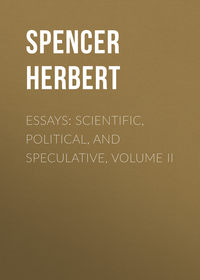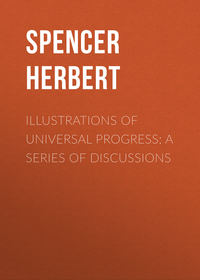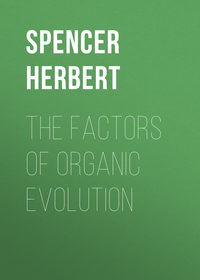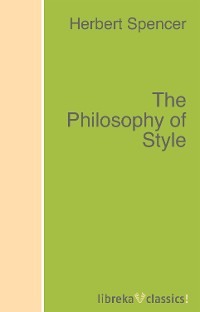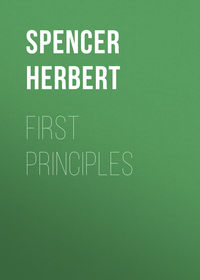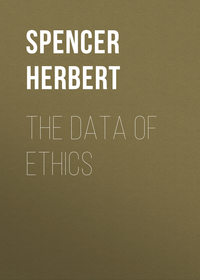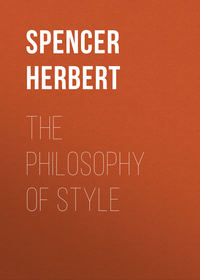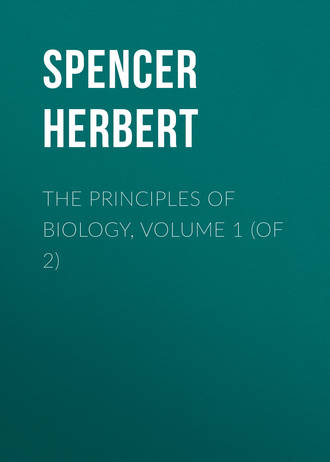 полная версия
полная версияThe Principles of Biology, Volume 1 (of 2)
A familiar fact supports this conclusion. Everyone has at hand, not figuratively but literally, an illustration. Let him compare the veins on the backs of his two hands, either with one another or with the veins on another person's hands, and he will see that the branchings and inosculations do not correspond: there is no fixed pattern. But on progressing inwards from the extremities, the distribution of the veins becomes settled – there is a pattern-arrangement common to all persons. These facts imply a predominating control by adjacent parts where control by the aggregate is less easy. A constant combination of forces which, towards the centre, produces a typical structure, fails to do this at the periphery where, during development, the play of forces is less settled. This peripheral vascular structure, not having become fixed because one arrangement is as good as another, is in each determined by the immediately surrounding influences.
§ 97e. And now let us contemplate the verifications which recent experiments have furnished – experiments made by Prof. G. Born of Breslau, confirming results earlier reached by Vulpian and adding more striking results of kindred nature. They leave no longer doubtful the large share taken by local organizing power as distinguished from central organizing power.
The independent vitality shown by separated portions of ventral skin from frog-larvæ may be named as the first illustration. With their attached yolk-cells these lived for days, and underwent such transformations as proved some structural proclivity, though of course the product was amorphous. Detached portions of tails of larvæ went on developing their component parts in much the same ways as they would have done if remaining attached. More striking still was the evidence furnished by experiments in grafting. These proved that the undifferentiated rudiment of an organ will, when cut off and joined to a non-homologous place in another individual, develop itself as it would have done if left in its original place. In brief, then, we may say that each part is in chief measure autogenous.
These strange facts presented by small aggregates of organic matter, which are the seats of extremely complex forces, will seem less incomprehensible if we observe what has taken place in a vast aggregate of inorganic matter which is the seat of very simple forces – the Solar System. Transcendently different as this is in all other respects, it is analogous in the respect that, as factors of local structures, local influences predominate over the influences of the aggregate. For while the members of the Solar System, considered as a whole, are subordinate to the totality of its forces, the arrangements in each part of it are produced almost wholly by the play of forces in that part. Though the Sun affects the motions of the Moon, and though during the evolution of the Earth-and-Moon system the Sun exercised an influence, yet the relations of our world and its satellite in respect of masses and motions were in the main locally determined. Still more clearly was it thus with Jupiter and his satellites or Saturn with his rings and satellites. Remembering that the ultimate units of matter of which the Solar System is composed are of the same kinds, and that they act on one another in conformity with the same laws, we see that, remote as the case is from the one we are considering in all other respects, it is similar in the respect that during organization the energies in each locality work effects which are almost independent of the effects worked by the general energies. In this vast aggregate, as in the minute aggregates now in question, the parts are practically autogenous.
Having thus seen that in a way we have not hitherto recognized the same general principles pervade inorganic and organic evolution, let us revert to the case of super-organic evolution from which a parallel was drawn above. As analogous to the germinal mass of units out of which a new organism is to evolve, let us take an assemblage of colonists not yet socially organized but placed in a fertile region – men derived from a society (or rather a succession of societies) of long-established type, who have in their adapted natures the proclivity towards that type. In passing from its wholly unorganized state to an organized state, what will be the first step? Clearly this assemblage, though it may have within the constitutions of its units the potentialities of a specific structure, will not develop forthwith the details of that structure. The inherited natures of its units will first show themselves by separating into large groups devoted to strongly-distinguished occupations. The great mass, dispersing over promising lands, will make preparations for farming. Another considerable portion, prompted by the general needs, will begin to form a cluster of habitations and a trading centre. Yet a third group, recognizing the demand for wood, alike for agricultural and building purposes, will betake themselves to the adjacent forests. But in no case will the primary assemblage, before these separations, settle the arrangements and actions of each group: it will leave each group to settle them for itself. So, too, after these divisions have arisen. The agricultural division will not as a whole prescribe the doings of its members. Spontaneous segregation will occur: some going to a pastoral region and some to a tract which promises good crops. Nor within each of these bodies will the organization be dictated by the whole. The pastoral group will separate itself into clusters who tend sheep on the hills and clusters who feed cattle on the plains. Meanwhile those who have gravitated towards urban occupations will some of them make bricks or quarry stone, while others fall into classes who build walls, classes who prepare fittings, classes who supply furniture. Then along with completion of the houses will go occupation of them by men who bake bread, who make clothing, who sell liquors, and so on. Thus each great group will go on organizing itself irrespective of the rest; the sub-groups within each will do the same; and so will the sub-sub-groups. Quite independently of the people on the hills and the plains and in the town, those in the forest will divide spontaneously into parties who cut down trees, parties who trim and saw them, parties who carry away the timbers; while every party forms for itself an organization of "butty" or "boss," and those who work under him. Similarly with the ultimate divisions – the separate families: the arrangements and apportionments of duties in each are internally determined. Mark the fact which here chiefly concerns us. This formation of a heterogeneous aggregate with its variously adapted parts, which while influenced by the whole are mainly self-formed, goes on among units of essentially the same natures, inherited from units who belonged to similar societies. And now, carrying this conception with us, we may dimly perceive how, in a developing embryo, there may take place the formation, first of the great divisions – the primary layers – then of the outlines of systems, then of component organs, and so on continually with the minor structures contained in major structures; and how each of these progressively smaller divisions develops its own organization, irrespective of the changes going on throughout the rest of the embryo. So that though all parts are composed of physiological units of the same nature, yet everywhere, in virtue of local conditions and the influence of its neighbours, each unit joins in forming the particular structure appropriate to the place. Thus conceiving the matter, we may in a vague way understand the strange facts of autogenous development disclosed by the above named experiments.
§ 97f. "But how immeasurably complex must be the physiological units which can behave thus!" will be remarked by the reader. "To be able to play all parts, alike as members of the whole and as members of this or that organ, they must have an unimaginable variety of potentialities in their natures. Each must, indeed, be almost a microcosm within a microcosm."
Doubtless this is true. Still we have a consensus of proofs that the component units of organisms have constitutions of extremely involved kinds. Contemplate the facts and their implications. (1) Here is some large division of the animal kingdom – say the Vertebrata. The component units of all its members have certain fundamental traits in common: all of them have proclivities towards formation of a vertebral column. Leaving behind the great assemblage of Fishes with its multitudinous types, each having special units of composition, we pass to the Amphibia, in the units of which there exist certain traits superposed upon the traits they have in common with those of Fishes. Through unknown links we ascend to incipient Mammalian types and then to developed Mammalian types, the units of which must have further superposed traits. Additional traits distinguish the units of each Mammalian order; and, again, those of every genus included in it; while others severally characterize the units of each species. Similarly with the varieties in each species, and the stirps in each variety. Now the ability of any component unit to carry within itself the traits of the sub-kingdom, class, order, genus, species, variety, and at the same time to bear the traits of immediate ancestors, can exist only in a something having multitudinous proximate elements arranged in innumerable ways. (2) Again, these units must be at once in some respects fixed and in other respects plastic. While their fundamental traits, expressing the structure of the type, must be unchangeable, their superficial traits must admit of modification without much difficulty; and the modified traits, expressing variations in the parents and immediate ancestors, though unstable, must be considered as capable of becoming stable in course of time. (3) Once more we have to think of these physiological units (or constitutional units as I would now re-name them) as having such natures that while a minute modification, representing some small change of local structure, is inoperative on the proclivities of the units throughout the rest of the system, it becomes operative in the units which fall into the locality where that change occurs.
But unimaginable as all this is, the facts may nevertheless in some way answer to it. As before remarked, progressing science reveals complexity within complexity – tissues made up of cells, cells containing nuclei and cytoplasm, cytoplasm formed of a protoplasmic matrix containing granules; and if now we conclude that the unit of protoplasm is itself an inconceivably elaborate structure, we do but recognize the complexity as going still deeper. Further, if we must assume that these component units are in every part of the body acting on one another by extremely complicated sets of forces (ethereal undulations emanating from each of the constituent molecules) determining their relative positions and actions, we are warranted by the discoveries which every day disclose more of the marvellous properties of matter. When to such examples as were given in § 36e we add the example yielded by recent experiments, showing that even a piece of bread, after subjection to pressure, exhibits diamagnetic properties unlike those it previously exhibited, we cannot doubt that these complex units composing living bodies are all of them seats of energies diffused around, enabling them to act and re-act so as to modify one another's states and positions. We are shown, too, that whatever be the natures of the complex forces emanating from each, it will, as a matter of course, happen that the power of each will be relatively great in its own neighbourhood and become gradually smaller in parts increasingly remote: making more comprehensible the autogenous character of each local structure.
Whatever be their supposed natures we are compelled to ascribe extreme complexity to these unknown somethings which have the power of organizing themselves into a structure of this or that species. If gemmules be alleged, then the ability of every organ and part of an organ to vary, implies that the gemmules it gives off are severally capable of receiving minute modifications of their ordinary structures: they must have many parts admitting of innumerable relations. Supposing determinants be assumed, then in addition to the complexity which each must have to express in itself the structure of the part evolved from it, it must have the further complexity implied by every superposed modification which causes a variation of that part. And, as we have just seen, the hypothesis of physiological units does not relieve us from the need for kindred suppositions.
One more assumption seems necessary if we are to imagine how changes of structure caused by changes of function can be transmitted. Reverting to § 54d, where an unceasing circulation of protoplasm throughout an organism was inferred, we must conceive that the complex forces of which each constitutional unit is the centre, and by which it acts on other units while it is acted on by them, tend continually to remould each unit into congruity with the structures around: superposing on it modifications answering to the modifications which have arisen in those structures. Whence is to be drawn the corollary that in course of time all the circulating units, – physiological, or constitutional if we prefer so to call them – visiting all parts of the organism, are severally made bearers of traits expressing local modifications; and that those units which are eventually gathered into sperm-cells and germ-cells also bear these superposed traits.
If against all this it be urged that such a combination of structures and forces and processes is inconceivably involved, then the reply is that so astonishing a transformation as that which an unfolding organism displays cannot possibly be effected by simple agencies.
§ 97g. But now let it be confessed that none of these hypotheses serves to render the phenomena really intelligible; and that probably no hypothesis which can be framed will do this. Many problems beyond those which embryology presents have to be solved; and no solution is furnished.
What are we to say of the familiar fact that certain small organs which, with the approach to maturity, become active, entail changes of structure in remote parts – that after the testes have undergone certain final developments, the hairs on the chin grow and the voice deepens? It has been contended that certain concomitant modifications in the fluids throughout the body may produce correlated sexual traits; and there is proof that in many of the lower animals the period of sexual activity is accompanied by a special bodily state – sometimes such that the flesh becomes unwholesome and even poisonous. But a change of this kind can hardly account for a structural change in the vocal organs in Man. No hypothesis of gemmules or determinants or physiological units enables us to understand how removal of the testes prevents those developments of the larynx and vocal cords which take place if they remain.
The inadequacy of our explanations we at once see in presence of a structure like a peacock's tail-feather. Mr. Darwin's hypothesis is that all parts of every organ are continually giving off gemmules, which are consequently everywhere present in their due proportions. But a completed feather is an inanimate product and, once formed, can add to the circulating fluids no gemmules representing all its parts. If we follow Prof. Weismann we are led into an astounding supposition. He admits that every variable part must have a special determinant, and that this results in the assumption of over two hundred thousand for the four wings of a butterfly. Let us ask what must happen in the case of a peacock's feather. On looking at the eye near its end, we see that the minute processes on the edge of each lateral thread must have been in some way exactly adjusted, in colour and position, so as to fall into line with the processes on adjacent threads: otherwise the symmetrical arrangement of coloured rings would be impossible. Each of these processes, then, being an independent variable, must have had its particular determinant. Now there are about 300 threads on the shaft of a large feather, and each of them bears on the average 1,600 processes, making for the whole feather 480,000 of these processes. For one feather alone there must have been 480,000 determinants, and for the whole tail many millions. And these, along with the determinants for the detailed parts of all the other feathers, and for the variable components of all organs forming the body at large, must have been contained in the microscopic head of a spermatozoon! Hardly a credible supposition. Nor is it easy to see how we are helped by the hypothesis of constitutional units. Take the feather in its budding state and ask how the group of such units, alike in structure and perpetually multiplying while the unfolding goes on, can be supposed by their mutual actions so to affect one another as eventually to produce the symmetrically-adjusted processes which constitute the terminal eye. Imagination, whatever licence may be given, utterly fails us.
At last then we are obliged to admit that the actual organizing process transcends conception. It is not enough to say that we cannot know it; we must say that we cannot even conceive it. And this is just the conclusion which might have been drawn before contemplating the facts. For if, as we saw in the chapter on "The Dynamic Element in Life," it is impossible for us to understand the nature of this element – if even the ordinary manifestations of it which a living body yields from moment to moment are at bottom incomprehensible; then, still more incomprehensible must be that astonishing manifestation of it which we have in the initiation and unfolding of a new organism.
Thus all we can do is to find some way of symbolizing the process so as to enable us most conveniently to generalize its phenomena; and the only reason for adopting the hypothesis of physiological units or constitutional units is that it best serves this purpose.
CHAPTER XI.
CLASSIFICATION
§ 98. That orderly arrangement of objects called Classification has two purposes, which, though not absolutely distinct, are distinct in great part. It may be employed to facilitate identification, or it may be employed to organize our knowledge. If a librarian places his books in the alphabetical succession of the author's names, he places them in such way that any particular book may easily be found, but not in such way that books of a given nature stand together. When, otherwise, he makes a distribution of books according to their subjects, he neglects various superficial similarities and distinctions, and groups them according to certain primary and secondary and tertiary attributes, which severally imply many other attributes – groups them so that any one volume being inspected, the general characters of all the neighbouring volumes may be inferred. He puts together in one great division all works on History; in another all Biographical works; in another all works that treat of Science; in another Voyages and Travels; and so on. Each of his great groups he separates into sub-groups; as when he puts different kinds of Literature under the heads of Fiction, Poetry, and the Drama. In some cases he makes sub-sub-groups; as when, having divided his Scientific treatises into abstract and concrete, putting in the one Logic and Mathematics and in the other Physics, Astronomy, Geology, Chemistry, Physiology, &c.; he goes on to sub-divide his books on Physics, into those which treat of Mechanical Motion, those which treat of Heat, those which treat of Light, of Electricity, of Magnetism.
Between these two modes of classification note the essential distinctions. Arrangement according to any single conspicuous attribute is comparatively easy, and is the first that suggests itself: a child may place books in the order of their sizes, or according to the styles of their bindings. But arrangement according to combinations of attributes which, though fundamental, are not conspicuous, requires analysis; and does not suggest itself till analysis has made some progress. Even when aided by the information which the author gives on his title page, it requires considerable knowledge to classify rightly an essay on Polarization; and in the absence of a title page it requires much more knowledge. Again, classification by a single attribute, which the objects possess in different degrees, may be more or less serial, or linear. Books may be put in the order of their dates, in single file; or if they are grouped as works in one volume, works in two volumes, works in three volumes, &c., the groups may be placed in an ascending succession. But groups severally formed of things distinguished by some common attribute which implies many other attributes, do not admit of serial arrangement. You cannot rationally say either that Historical Works should come before Biographical Works, or Biographical Works before Historical Works; nor of the sub-divisions of creative Literature, into Fiction, Poetry, and the Drama, can you give a good reason why any one should take precedence of the others.
Hence this grouping of the like and separation of the unlike which constitutes Classification, can reach its complete form only by slow steps. I have shown (Essays, Vol. II., pp. 145-7) that, other things equal, the relations among phenomena are recognized in the order of their conspicuousness; and that, other things equal, they are recognized in the order of their simplicity. The first classifications are sure, therefore, to be groupings of objects which resemble one another in external or easily-perceived attributes, and attributes that are not of complex characters. Those likenesses among things which are due to their possession in common of simple obvious properties, may or may not coexist with further likenesses among them. When geometrical figures are classed as curvilinear and rectilinear, or when the rectilinear are divided into trilateral, quadrilateral, &c., the distinctions made connote various other distinctions with which they are necessarily bound up; but if liquids be classed according to their visible characters – if water, alcohol, sulphuret of carbon, &c., be grouped as colourless and transparent, we have things placed together which are unlike in their essential natures. Thus, where the objects classed have numerous attributes, the probabilities are that the early classifications, based on simple and manifest attributes, unite under the same head many objects that have no resemblance in the majority of their attributes. As the knowledge of objects increases, it becomes possible to make groups of which the members have more numerous properties in common; and to ascertain what property, or combination of properties, is most characteristic of each group. And the classification eventually arrived at is of such kind that the objects in each group have more attributes in common with one another than they have in common with any excluded objects; one in which the groups of such groups are integrated on the same principle; and one in which the degrees of differentiation and integration are proportioned to the degrees of intrinsic unlikeness and likeness. And this ultimate classification, while it serves to identify the things completely, serves also to express the greatest amount of knowledge concerning the things – enables us to predicate the greatest number of facts about each thing; and by so doing implies the most precise correspondence between our conceptions and the realities.
§ 99. Biological classifications illustrate well these phases through which classifications in general pass. In early attempts to arrange organisms in some systematic manner, we see at first a guidance by conspicuous and simple characters, and a tendency towards arrangement in linear order. In successively later attempts, we see more regard paid to combinations of characters which are essential but often inconspicuous, and an abandonment of a linear arrangement for an arrangement in divergent groups and re-divergent sub-groups.
In the popular mind, plants are still classed under the heads of Trees, Shrubs, and Herbs; and this serial classing according to the single attribute of magnitude, swayed the earliest observers. They would have thought it absurd to call a bamboo, thirty feet high, a kind of grass; and would have been incredulous if told that the Hart's-tongue should be placed in the same great division with the Tree-ferns. The zoological classifications current before Natural History became a science, had divisions similarly superficial and simple. Beasts, Birds, Fishes, and Creeping-things are names of groups marked off from one another by conspicuous differences of appearance and modes of life – creatures that walk and run, creatures that fly, creatures that live in the water, creatures that crawl. And these groups were thought of in the order of their importance.




